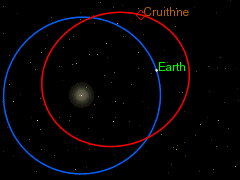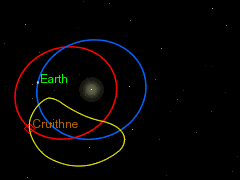 | |
| Discovery | |
|---|---|
| Discovered by | Duncan Waldron |
| Discovery date | October 10, 1986 |
| Designations | |
| Alternate name | 1983 UH; 1986 TO |
| Minor planet category | Near-Earth asteroid, Venus-crosser asteroid, Mars-crosser asteroid |
| Epoch June 18, 2009 (JD 2455000.5) | |
| Aphelion | 226.105 Gm (1.51 AU) |
| Perihelion | 72.415 Gm (0.484 AU) |
| Semi-major axis | 149.260 Gm (0.998 AU) |
| Eccentricity | 0.515 |
| Orbital period | 364.01 d (1.00 a) |
| Average orbital speed | 27.73 km/s |
| Mean anomaly | 170.36° |
| Inclination | 19.81° |
| Longitude of ascending node | 126.28° |
| Argument of perihelion | 43.74° |
| Physical characteristics | |
| Dimensions | ~5 km |
| Mass | 1.3×1014 kg |
| Mean density | 2 ? g/cm³ |
| Equatorial surface gravity | 0.0014 m/s² |
| Escape velocity | 0.0026 km/s |
| Rotation period | 27.44 h[1] |
| Temperature | ~275 K |
| Spectral type | ? |
| Absolute magnitude (H) | 15.1[1] |
| | |
3753 Cruithne (pronounced /ˈkrɪnjə/, from Old Irish [ˈkrɪθnɛ]; Modern [ˈkrɪhnʲə] or [ˈkrɪnʲə]) is an asteroid in orbit around the Sun in 1:1 orbital resonance with that of the Earth. It is a periodic inclusion planetoid orbiting the Sun in an apparent horseshoe orbit.[2] It has been called "Earth's second moon", although it is only a quasi-satellite.[2]
Discovery
Cruithne was discovered on October 10, 1986, by Duncan Waldron on a photographic plate taken with the UK Schmidt Telescope at Siding Spring Observatory, Coonabarabran, Australia. The 1983 apparition (1983 UH) is credited to Giovanni de Sanctis and Richard M. West of the European Southern Observatory in Chile. It was not until 1997 that its unusual orbit was determined by Paul Wiegert and Kimmo Innanen, working at York University in Toronto, and Seppo Mikkola, working at the University of Turku in Finland.
The asteroid is named after the Cruithne people (also known as the Priteni or the Picts) who inhabited Scotland and parts of Ireland and the Isle of Man between 800 BCE and 1000 CE[citation needed]; the name may specifically refer to their legendary first leader, also called Cruithne.
Dimensions and orbit
Cruithne is approximately 5 km in diameter, and its closest approach to Earth is approximately 30 times the separation between Earth and the Moon (12 Gm or million kilometres). From 1994 through 2015, Cruithne will make its annual closest approach to Earth every November.[3] Although Cruithne's orbit is not thought to be stable over the long term, calculations by Wiegert and Innanen showed that it has likely been synchronized with Earth's orbit for a long time. There is no danger of a collision with Earth for millions of years, if ever. Its orbital path and Earth's do not cross, and its orbital plane is currently tilted to that of the Earth by 19.8°. Cruithne, having a maximum opposition magnitude of +15.8, is fainter than Pluto and would require at least a 12.5-inch (320 mm) reflecting telescope to be seen.[4][5]
Cruithne is in a normal elliptic orbit around the Sun. Its period of revolution around the Sun, approximately 364 days at present, is almost equal to that of the Earth. Because of this, Cruithne and Earth appear to "follow" each other in their paths around the Sun. This is why Cruithne is sometimes called "Earth's second moon".[2] However, it does not orbit the Earth and is not a moon.[6] In 2058, Cruithne will come within 0.09 AU (13.6 million kilometres) of Mars.[3] Cruithne's distance from the Sun and orbital speed vary a lot more than the Earth's, so from the Earth's point of view Cruithne actually follows a kidney bean-shaped horseshoe orbit ahead of the Earth, taking slightly less than one year to complete a circuit of the "bean". Because it takes slightly less than a year, the Earth "falls behind" the bean a little more each year, and so from our point of view, the circuit is not quite closed, but rather like a spiral loop that moves slowly away from the Earth.
After many years, the Earth will have fallen so far behind that Cruithne will then actually be "catching up" on the Earth from "behind". When it eventually does catch up, Cruithne will make a series of annual close approaches to the Earth and gravitationally exchange orbital energy with Earth; this will alter Cruithne's orbit by a little over half a million kilometres (whilst Earth's orbit is altered by about 1.3 centimetres) so that its period of revolution around the Sun will then become slightly more than a year. The kidney bean will then start to migrate away from the Earth again in the opposite direction — instead of the Earth "falling behind" the bean, the Earth is "pulling away from" the bean. The next such series of close approaches will be centred on the year 2292 — in July of that year, Cruithne will approach Earth to about 12.5 million km.
After 380 to 390 years or so, the kidney-bean-shaped orbit approaches Earth again from the other side, and the Earth, once more, alters the orbit of Cruithne so that its period of revolution around the Sun is again slightly less than a year (this last happened with a series of close approaches centred on 1902, and will next happen with a series centered on 2676). The pattern then repeats itself.
Similar minor planets
More near-Earth objects (NEOs) have since been discovered. These include 54509 YORP, (85770) 1998 UP1, 2002 AA29, and 2009BD which exist in resonant orbits similar to Cruithne's.
Other examples of natural bodies known to be in horseshoe orbits include Janus and Epimetheus, natural satellites of Saturn. The orbits these two moons follow around Saturn are much simpler than the one Cruithne follows, but operate along the same general principles.
Mars has four known co-orbital asteroids (5261 Eureka, 1999 UJ7, 1998 VF31, and 2007 NS2, all at the Lagrangian points), and Jupiter has many (more than 1000 known objects, the Trojan asteroids); there are also other small co-orbital moons in the Saturnian system: Telesto and Calypso with Tethys, and Helene and Polydeuces with Dione. However, none of these follow horseshoe orbits.
See also
- 2006 RH120
- Asteroids in fiction: Other asteroids, Asteroids in fiction: Colonization, and Asteroids in fiction: Mining
- Co-orbital moon
- Earth's second moon
- Natural satellite
- Quasi-satellite
- Steven Baxter's "Manifold: Time", a novel in which Cruithne plays a major role; nominated for the Arthur C. Clarke science fiction award in 2000



